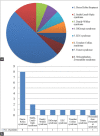The Influence of Genetic Syndromes on the Algorithm of Cleft Lip and Palate Repair - A Retrospective Study
- PMID: 35265497
- PMCID: PMC8848705
- DOI: 10.4103/ams.ams_77_21
The Influence of Genetic Syndromes on the Algorithm of Cleft Lip and Palate Repair - A Retrospective Study
Abstract
Introduction: This study aimed to determine if the treatment algorithm used for nonsyndromic cleft patients required alteration to manage syndromic cleft lip and/or palate patients.
Methods: The records of patients managed by the Pécs Cleft Team between January 1999 and December 2015 were analyzed retrospectively. The sources of the data included clinical and genetic records.
Results: A total of 607 patients were managed by the cleft team during the study. Sixteen patients (2.6%) were noted to be afflicted with a particular identifiable syndrome. Seven different genetic syndromes and one sequence were present in the study. The Pierre Robin sequence occurred most often, comprising 50% of the cohort. The treatment algorithm used in managing nonsyndromic clefts required modification in 13 of the 16 syndromic patients.
Discussion: The presence of a genetic syndrome may notably affect the treatment algorithm in children born with cleft lip and/or palate. The surgical treatment of certain associated anomalies has by necessity, priority over the timing of the reconstruction of the cleft lip and/or cleft palate in syndromic patients.
Keywords: Child; cleft lip; cleft palate; syndrome; treatment timing.
Copyright: © 2021 Annals of Maxillofacial Surgery.
Conflict of interest statement
Dr. George Kalman Sandor was associated as a section editor of this journal and this manuscript was subject to this journal's standard review procedures, with this peer review handled independently of this section editor and their research group.
Figures





Similar articles
-
[Complex management of children affected with cleft lip and palate associated with genetic syndromes].Orv Hetil. 2022 May 22;163(21):826-831. doi: 10.1556/650.2022.32500. Print 2022 May 22. Orv Hetil. 2022. PMID: 35598212 Hungarian.
-
Need for velopharyngeal management following palatoplasty: an outcome analysis of syndromic and nonsyndromic patients with Robin sequence.Plast Reconstr Surg. 1997 May;99(6):1522-9; discussion 1530-4. Plast Reconstr Surg. 1997. PMID: 9145119
-
[Epidemiology of malformations associated with cleft lip and palate: a retrospective study of 324 cases].Arch Pediatr. 2015 Aug;22(8):816-21. doi: 10.1016/j.arcped.2015.05.005. Epub 2015 Jul 2. Arch Pediatr. 2015. PMID: 26142764 French.
-
An update on the aetiology of orofacial clefts.Hong Kong Med J. 2004 Oct;10(5):331-6. Hong Kong Med J. 2004. PMID: 15479962 Review.
-
[Comparison of different types of cleft lip and palate in regards to dental anomalies and sexual incidence].J Dent Que. 1991 Feb;28:49-53. J Dent Que. 1991. PMID: 1869697 Review. French.
Cited by
-
The Brain in Oral Clefting: A Systematic Review With Meta-Analyses.Front Neuroanat. 2022 Jun 10;16:863900. doi: 10.3389/fnana.2022.863900. eCollection 2022. Front Neuroanat. 2022. PMID: 35756498 Free PMC article.
-
Optimal timing for plastic surgical procedures for common congenital anomalies: A review.World J Clin Pediatr. 2024 Jun 9;13(2):90583. doi: 10.5409/wjcp.v13.i2.90583. eCollection 2024 Jun 9. World J Clin Pediatr. 2024. PMID: 38947997 Free PMC article. Review.
References
-
- Corcoran M, Karki S, Harila V, Luoto A, Ylikontiola L, Sándor GK, et al. Dental fear among adolescents with cleft. Int J Paediatr Dent. 2021:1–8. - PubMed
-
- Cohen MM., Jr Syndromes with cleft lip and cleft palate. Cleft Palate J. 1978;15:306–28. - PubMed
-
- Irfanulla Khan AN, Prashanth CS, Srinath N. Genetic etiology of cleft lip and cleft palate. AIMS Mol Sci. 2020;7:328–48.
LinkOut - more resources
Full Text Sources
